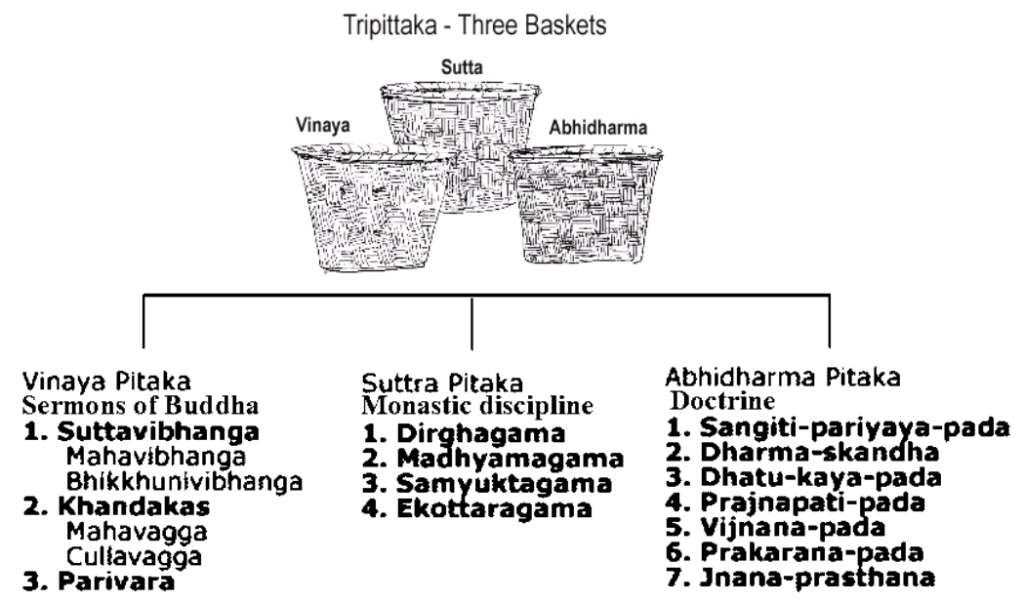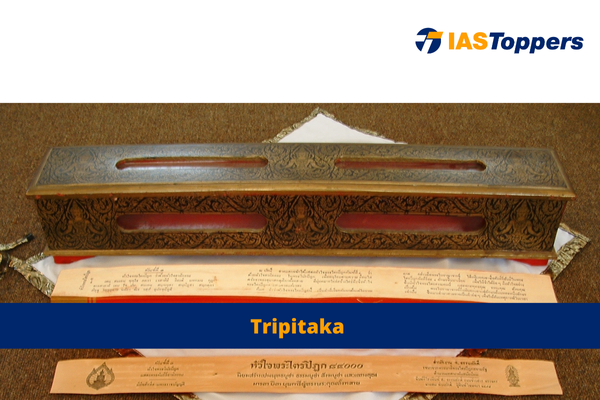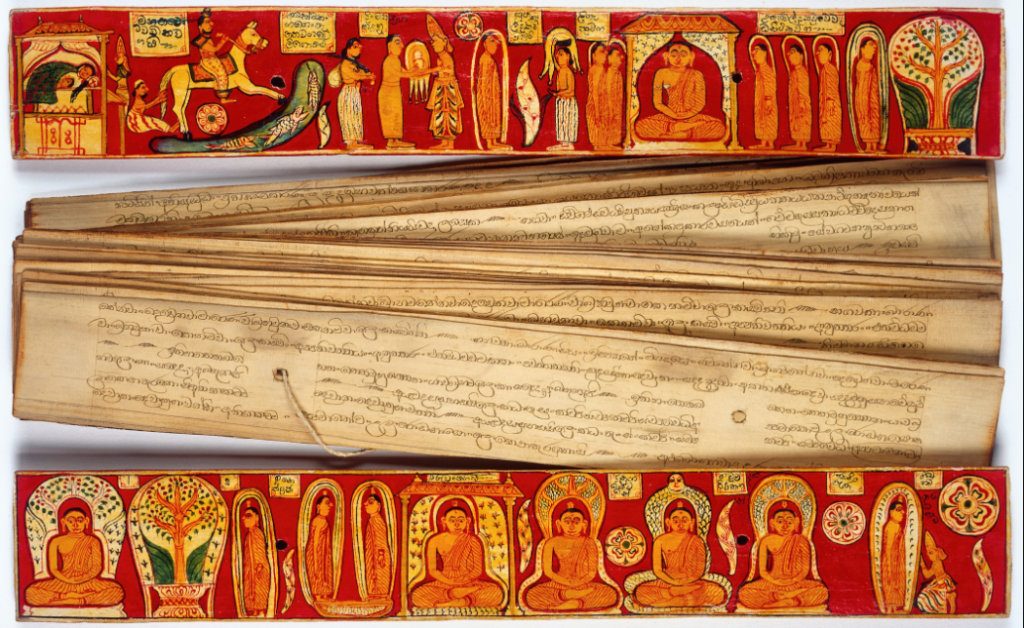The Tripitaka, also known as Tipitaka, forms the cornerstone of Theravada Buddhism. It represents the earliest recorded teachings of Buddha and his disciples, written in three parts or “baskets” – Vinaya Pitaka, Sutta Pitaka, and Abhidhamma Pitaka. Each part has its distinct relevance – Vinaya Pitaka provides guidance for monastic life, Sutta Pitaka contains the essence of Buddhist teachings, and Abhidhamma Pitaka offers a detailed analysis of ethics, psychology, and epistemology. In this article, you will know about meaning and definition of Tripitaka, and its 3 parts. To explore more interesting UPSC Ancient India topics of GS Paper 1 like Tripitaka, check out other articles and IAS Notes of IASToppers.
Table of Content
- What is Tripitaka?
- Vinaya Pitaka
- Sutta Pitaka
- Abhidhamma Pitaka
- Conclusion
- FAQs on Tripiṭaka
What is Tripitaka?

- The Tripitaka, also known as the Tipitaka, is a foundational text in the Theravada Buddhism tradition.
- This three-part collection, whose name translates to “three baskets” from Pali, consists of earliest known teachings from Buddha and his disciples.
- Considered the voice of Buddha by Theravada Buddhists, the Tripitaka was compiled in a First Buddhist council held shortly after Buddha’s death in 4th century B.C.E.
- This knowledge was transmitted orally before being documented in 3rd century B.C.E.
- The Tripitaka is divided into three components: Vinaya Pitaka, Sutta Pitaka, and Abhidhamma Pitaka.
- The Theravada school’s Tripitaka is the only full Tripitaka preserved in Pali.
- The Sarvastivada is Tripitaka that is available in Sanskrit, Chinese, and Tibetan languages.
- Other versions of the Tripitaka are Mahasanghika, Mahisasaka, Mulasarvastivada, and Kasyapiya.
- The term “Tripiṭaka” also applies broadly in Mahayana Buddhism, referencing the entire body of Buddhist scriptures.
- It is believed that every one of the first 18 types of Buddhism had their own Tripiṭaka.
- When Mahayana Buddhism was growing, new texts were added. These included both Mahayana teachings and writings by important thinkers like Nagarjuna.
- Later, even more material was added from Tantric tradition. That is why the Tripitaka is not so clear in the Chinese and Tibetan versions of the Tripiṭaka.
Vinaya Pitaka
- Vinaya Piṭaka is the oldest and smallest of the three sections of Tipiṭaka.
- It consists of various regulations laid down by Buddha himself to guide the monastic life and daily affairs of monks and nuns.
- The Vinaya Pitaka does not vary much from one Buddhist school to another, with the fundamental rules largely remaining the same across schools, including the Mahayana ones.
- Vinaya Pitaka is subdivided into three primary components:
Sutta-vibhanga
- The books of Parajika and Pachittiya jointlyform the Sutta Vibhanga.
- Parajika: Deals with the eight various forms of Vinaya transgressions. Disciplinary actions are also prescribed for each offense, arranged according to severity.
- Pachittiya: Provides an extended understanding of the Parajika, focusing particularly on nuns.
- A Parajika offense leads to expulsion from the monastic community or Sangha, whereas a Pachittiya violation results in a penance for a prescribed duration.
Khandhaka
- The books of Chullavagga and Mahavagga jointlyform the Khandhakas or Treatises.
- Chullavagga: Showsdisciplinary punishments for those who transgress, the procedure for suspension, and special instructions for nuns.
- Mahavagga: Shows evolution and progress of the Buddhist monks, has details of rules for joining the Buddhist order, Uposatha ceremony (fortnightly meetings of the Buddhist monastic assembly), Pravarana (Buddhist holy day), barsabas (retreat), dietary guidelines, accommodations, medicinal requirements, clothing etc. for monks.
Parivara
- Parivara functions as an appendix, offering a summary of the rules presented in the other Vinaya texts, particularly prevalent in the Theravada school.
Sutta Pitaka
- The Sutta (religious advice) Pitaka is the second part of the Tripitaka.
- It shows the crux of Buddhist teachings as conveyed by Gautama Buddha to his followers, both monks and laypersons.
- The principles of Buddhism, Sila (ethical conduct), Samadhi (meditation) and Prajna (wisdom), has been explained in the Sutta Pitaka.
- The treatise also sheds light on the Four Noble Truths of Buddhism which include concepts like Pratityasamutpada (dependent origination), Karmavada (law of action and reaction) and Nirvana (ultimate liberation).
- The Sutta Pitaka also provides a glimpse into the socio-economic and political landscape of Buddha’s era, as well as the prevalent religious beliefs.
- It is further categorized into five Nikayas or collections of discourses:
- Khuddakanikaya (Short Collection): A collection of 15 books on numerous topics related to Buddhism
- Majjhamanikaya (Medium Collection): Has discourses analyzing diverse Buddhist doctrines. It deals with monastic life, the evils of caste, Buddha’s debates with the Jains etc.
- Dighanikaya (Long Collection): Has 34 extensive discourses touching on Buddha’s life such as fundamental Buddhist doctrines, principles of caste, chain of causation, domestic and social ethics etc.
- Samyuttanikaya (Cluster Collection): Has concise suttas categorized into 56 samyuttas (groups) on various topics Buddha’s first sermon.
- Abguttaranikaya (Item-more Collection): Has small suttas grouped into 11 nipatas (chapters)on topics like places of pilgrimage, kinds of wealth, types of persons etc.
- Sanskrit writings present these texts as Agamas, while the Pali version labels them as Nikayas, the latter adding a fifth group known as the Khuddaka Nikaya.
- The Sutta Pitaka is comprehensive guide to understanding the teachings of Buddhism in their purest and most authentic form.
Abhidhamma Pitaka
- Abhidhamma Pitaka is the third segment of Tripitaka.
- Unlike the other two parts, Abhidhamma Pitaka is more theoretical and philosophical, presenting subjects in an organized and methodical manner.
- Despite the claim that these texts are not Buddha’s own words but those of his disciples and great scholars, they hold significant importance, especially in Myanmar (Burma).
- This part of the canon is further subdivided into seven books that talks about ethics, psychology, and epistemology.
- Dhammasangani: Focuses on mental conditions, including both worldly and beyond-worldly domains.
- Vibhanga: Offers a synthesis of the mental conditions analyzed in Dhammasangani.
- Dhatukatha: Discusses the elements of mental phenomena and their interconnections.
- Puggalapannatti: Debates on the essence of personality
- Kathavatthu: Criticizes numerous views from a Theravada perspective.
- Yamaka: Series of inquiries about psychological phenomena
- Patthana: Has analysis of causality and relationships between mental phenomena.
- The acceptance of Abhidhamma corpus as canonical has varied across different schools of Buddhism. Some, like the Mahasanghika, do not recognize it as canonical, while others included parts of the Khuddaka Nikaya from the Sutta Pitaka into it.
Conclusion
The Tripitaka, with its three comprehensive parts serves as a guide for ethical conduct, a source of Buddhist teachings, and a platform for detailed analysis of various psychological phenomena. As the foundation of Theravada Buddhism, it enables followers to gain deep insights into the Buddhist way of life, thus promoting spiritual growth and self-realization.
Ref: Source-1
| Other Articles in History & Culture | |
| Pala Dynasty | Gupta Coins |
| Harappan Architecture | Miniature Painting |
| Theravada Buddhism | Ajanta and Ellora Caves |
FAQs (Frequently Asked Questions)
Tripitaka texts are related with which religion?
Tripitakas are sacred books of Theravada Buddhism, containing the earliest recorded teachings of Buddha and his disciples.
Tripitaka was written in which language?
The Tripitaka was originally written in Pali, a Middle Indo-Aryan language native to the Indian subcontinent
What is the difference between Tripitaka and Jataka?
The Tripitaka is the primary scripture of Theravada Buddhism, encompassing ethical guidance, Buddhist teachings, and analytical discourses, whereas the Jataka refers to a collection of stories about the previous lives of the Buddha.



